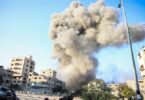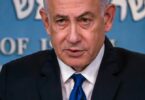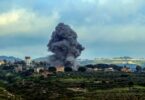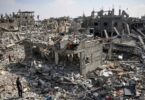Ibrahim Karagul
What does “head” of the Catholic Ch-urch, Pope Fra-ncis’ visit to Iraq, his meeting with Shiite leader Aya-tollah Ali Sistani in Najaf, and hence the proclamation of March 7 in Iraq as “national day” tell us?
What was the political message given through the “photograph” of the Pope and Sistani’s meeting? Is it an attempt at an interfaith dialogue? Or is it just a step towards a much more dangerous “Islamic civil war”!
Master, boss Pope on one side, Fearful, meek Sistani on the other…
On one side there is the Pope, “dominant,” “powerful,” a “master” watching over, questioning, without a trace of humility, looks like he is checking on a colony country.
On the other side, there is Sistani, “meek,” helpless, exhausted, sitting quietly afraid to be scolded, looking obedient with his hands on his knees, waiting to receive instructions.
Considering this picture in the context of the events in Iraq and its surroundings, in our region in the last three centuries, we visualize a heavily insulting web of relations, a region design, a power map.
Shiite-Sunni disintegration: Not an innocent visit.
This visit and photograph were surely not perceived as innocent in Turk-ey and many regional countries, nor on their streets, or in the minds of their peoples.
They were seen as new steps from the past to a dark future, new breakthroughs in today’s Middle Eastern power equilibrium, new projects and alliances in the Shiite-Sunni disintegration.
The fact that Eastern nations and countries’ eagerness to “be Western” is impossible in any format other than “being the West’s colony” is a historical experience.
Many countries and nations attempted this and experienced great changes. They achieved nothing other than being one of the West’s colony countries. They were taken hostage and devastated. The same countries and nations paid – and are continuing to pay – great prices to break free from these shackles.
Spiritual foundations of alliance between Iran, West
It is clear what the Iraqi government expects from the Pope’s visit. The expectation from the Pope’s Erbil visit is no different. However, this is not what we are discussing.
A deeper, long-term fo-rm of reading that includes major plans concerning the region’s future beyond sta-tes and countries is important. The image of Sistani and the Pope together presents new signs of this deep affair, this web of alliances. Is the foundation of a new regional alliance being laid between the West and the Shiite world?
Do the political, military and geopolitical plans make up the basis of the spiritual foundations of this web of relations, which we are seeing in the pursuits for power?
Alliance between Iran, West: Sieging the Sunni world?
Speaking in more concrete terms, could the Pope’s visit be a part of a new “siege” plan for the region’s Sunni world by strengthening the West-Iran line? Iraq is under Western and Iranian occupation. This thus presents convenience for such a partnership.
Similar attempts have been made on numerous occasions over the centuries. There are many ex-amples of alliance and po-wer solidarity between Iran and the West against every rising power in the region. There have been attempts to build a line of solidarity in the East against every power that poses a threat to the West, including the Ottoman Empire.
Every intervention by the West on our region in the last three decades provided a power gain for Iran and increased its effectiveness. The Iran-U.S. and Iran-Israel conflicts, on the contrary, ensured such reciprocal gains.
Is West building a new front with Iran to siege Turkey?
Could the Pope’s visit and meeting with Sistani be the sign of a new siege project for Turkey?
Turkey is the world’s rising power. Turkey’s effect is rapidly spreading from Libya to the Caucasus, from northern Iraq to Syria, from Somalia to the Balkans, which is leading to deep questioning in the Western world. Projects to siege from the Iraqi-Syrian border, from the East Mediterranean, from the Aegean are aimed at “stopping Turkey.”
Could Iran, which opposed Azerbaijan’s efforts to save its own territory in Karabakh by supporting Armenia, be taking a new position for the West’s great plan aimed at “stopping Turkey”?
Did the Sunni Arab front fail?
The West tried this in the last five years through Sau-di Arabia and the United Arab Emirates (UAE). It built a “Sunni Arab front” spanning the Persian Gulf and Egypt against Turkey. The foundation of the front was laid on the Sunni Arab-Israel axis.
While this front was facing the Iranian threat, it was suddenly positioned against Turkey. The same front was on the West axis established against Turkey in the Karabakh war, in Syria and Iraq, and in the Aegean and East Mediterranean siege.
However, the lack of trust between the Arab world and the U.S. prevailed in the recent period. The cease of support to the Saudis in Yemen, the blackmail on Riyadh using the Jamal Khashoggi case, the rapprochement between the U.S. and Iran are some examples.
Mediterranean deal with Egypt. Hot new messages from region.
Just as tensions in Iran-Saudi Arabia relations were further escalating, ballistic missile attacks on Saudi Arabia from Yemen were intensified.
Saudi Arabia and the UAE starting giving hot new messages to Turkey. Meetings between Turkey and Egypt on the Mediterranean gained pace.
In fact, similar to the Turkey-Libya deal, both Foreign Minister Mevlüt Çavusoglu and Defense Minister Hulusi Akar announced that a maritime deal may be signed with Egypt as well.
Just as the U.S. and Israel had positioned the “Arab front” against Turkey, they Arab front has been surprised with the U.S.-Iran rapprochement.
Iranian organizations: ‘We will fight Turkey in Sinjar’
They mobilized Arabs saying “Turkey is a big threat to you.” Following the geopolitical power change in the Caucasus after the Karabakh war, they started to inject the same fear in Iran as well. They know that the Tehran administration already has this concern.
Hashd al-Shaabi and other organizations affiliated with Iran are fighting Turkey in Syria. In fact, they are openly acting jointly with the Kurdistan Workers’ Party (PKK). Hashd al-Shaabi and other Iranian organizations are making daily threats against the terrorist operations in northern Iraq.
Statements along the lines of, “We will fight Turkey if the Sinjar operations launches,” have become a daily thing. Tehran’s announcement of Turkey as an “Occupier in Iraq,” giving new instructions to these organizations, while it is in fact Iran and the U.S. that are occupying Iraq together.
Laying siege to Turkey from the East with Iran
Now, the question is this: Is the West, which is trying to stop Turkey by building an Arab front, planning a new siege by building a Shiite-Iran front?
Upon realizing that it cannot stop Turkey with Arabs, is it planning to siege Turkey from the East by investing in a sectarian divide in the Islamic world?
There is no doubt that every partnership the West establishes in our region is against Turkey. This is the primary objective, the rest is nothing other than futile talk and obscuration.
We now know of their plans to siege through terrorism in Syria and Iraq, th-rough Greece, the U.S., Fr-ance, Israel and the Arab fr-ont from the East Medite-rranean and the Aegean.
Are they now going to build the East line of the same front with Iran? Because the “corridor map” from the Mediterranean to the Iranian border was the first step to this.
New Crusaders: They know well that if Turkey is stopped, the region will collapse.
President Recep Tayyip Erdogan’s recent statements emphasizing the siege from the south and the Mediterranean need to be read carefully. His statements with respect to Turkey’s great fight and what a painful regional showdown this is need to be discussed one by one.
Will Iran be a partner to the “New Crusader Attacks” targeting Turkey? Will Tehran be tasked with stopping Turkey? They know very well that the region will collapse if Turkey is stopped.
There is just so much to discuss over the Pope-Sistani photograph.
This is certainly not an innocent meeting.






